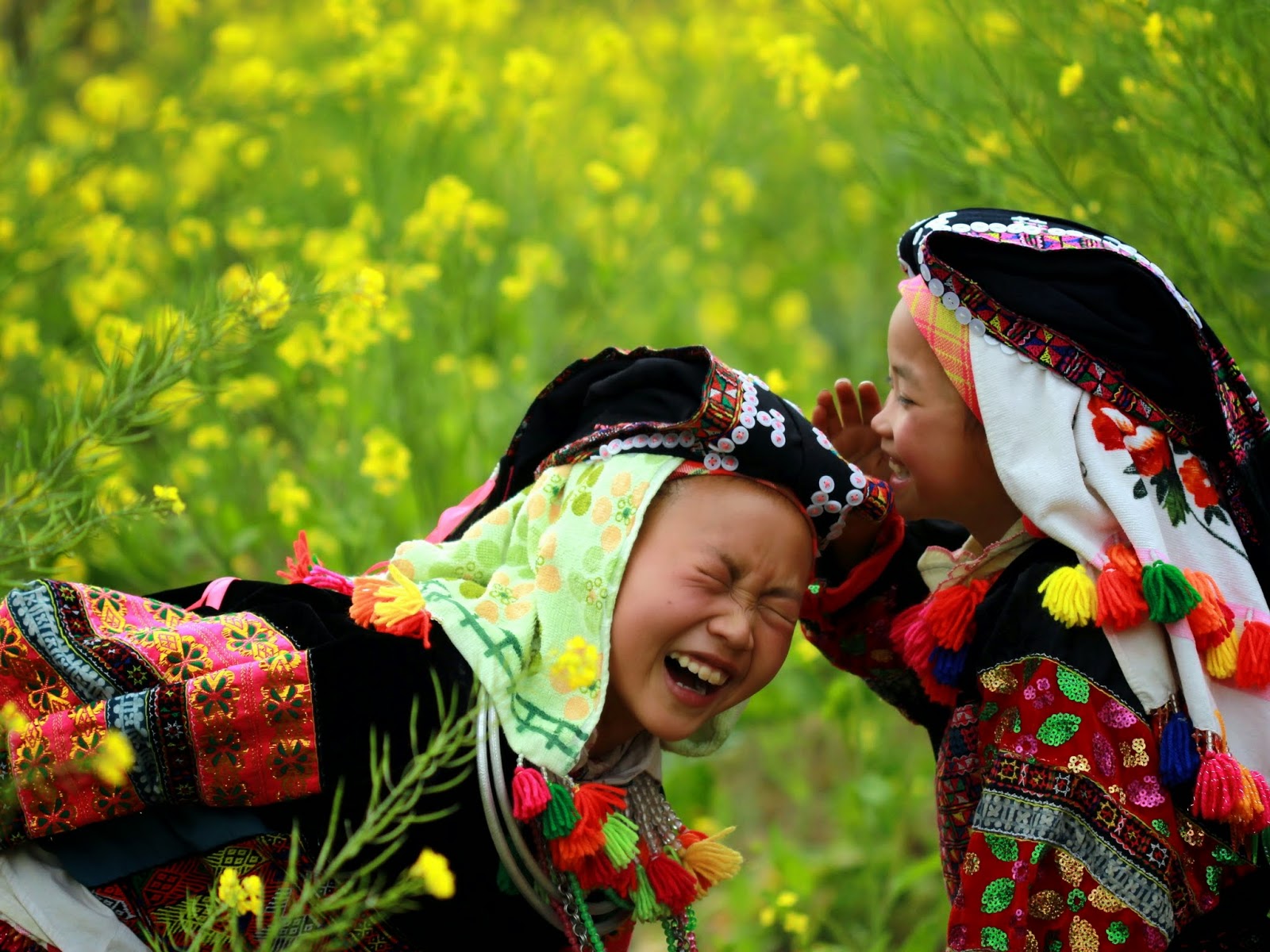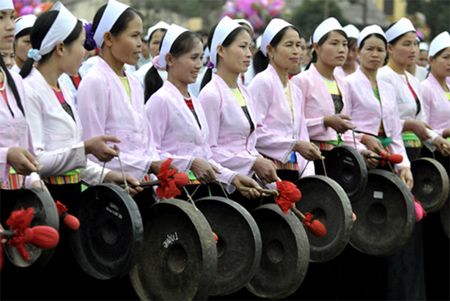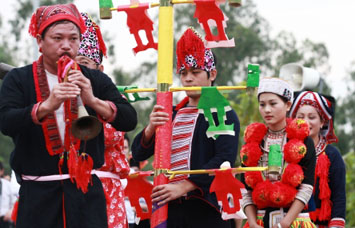 |
| Illustrative image |
Following are traditional Tet festival customs of some ethnic minority groups in Vietnam including Muong ethnic minority, Tay ethnic minority, Cham people,Co Tu ethnic people, Dao ethnic minority, Sedang ethnic minority, H’mong ethnic minority, Hre ethnic minority,Thai ethnic minority, San Chi ethnic minority and Ede ethnic minority.
1. Tay ethnic minority
The Tet festival of Tay ethnic people starts on the 30th of the last lunar month to the morning of the third day of the New Year. On the seventh day of the Lunar New Year, they go to work in field, but only as a formality. On the 15th day of the first lunar month, they celebrate Tet festival again.
Different from Thai ethnic people, Tay ethnic minority’s taboo is that a person who is not invited to come their home on the first day of the Lunar New Year. The first caller on New Year’s Day chosen is a virtuous person or a person well respected in the hamlet, and they especially refrain anyone in mourning. On the first day of the Lunar New Year, Tay ethnic men usually go to their parents-in-law to wish a Happy New Year and the third day of the New Year to wish magician.
Some folk games are also played during the Tet such as con-ball throwing game. After the Tet, Tay ethnic group organize Long Tong festival, meaning going to the rice field.
 |
2. Muong ethnic minority
In term of sequence and customs, the Tet festival of Muong ethnic minority people is quite similar to the Tet Festival of Kinh people. There is a unique tradition of “sac bua” singing that is being preserved. This is a kind of singing to wish Happy New Year.
On the first and second days of the first month of the Lunar New Year, Muong children gather together to beat gongs and sing “sac bua”. They go through any household, which opens its doors to give children some money or cake.The popular games during the New Year of the Nung ethnic minority are the “con” ball throwing game, shuttle cock kicking, duet singing between male and female, and traditional martial arts. Children usually play humming-top and lion dance.
3. Co Tu ethnic people
On the Lunar New Year festival of the Co Tu people, the crossbows, spears, broadsword, cymbal, drums and gongs are carefully cleaned. Many cultural activities take place in Guol house (communal house) such as telling stories, dancing, singing folk songs. Co Tu girls have chance to exchange feelings and invite each other to play spring for a month-long.
4. Dao ethnic minority
et festival of the Dao ethnic minority usually takes place in the first month of the lunar calendar, beginning a new year with good weather and a lush green harvest. This is a nice traditional culture of Dao people.
Before the festival, Dao people usually prepare an altar. Altar column is made of four timbers, surrounded with bamboo. Inside the altar are three big round tubes, used as thuribles symbolizing sky, land and people. There is votive paper money in the censers. Space under of the alter is a bundle of sugar-cane to wish for sweet things.
 |
At the festival, four youths wearing good clothes carry offerings on their heads to selected position from four different sides. Offering are boiled chicken, sticky cake, sweet cake and votive money paper. The offering tray must have male and female, so necessity has both cock and hen. The wizard reads aloud prayer for good weather, lush harvests, children’s successful study and happiness.
At the end of the ceremony, the people together take part in festival activities with folk game such as tug of war, pushing stick, con throwing. For con throwing, Dao people believe that if someone successfully throws at the first round they shall have much good luck.
5. Cham people
Like other ethnic groups, the Cham ethnic people also celebrate their Tet sumptuously. They kill pigs, poultry and enjoy a variety of fruits and cakes. During the Lunar New Year Festival, the Cham ethnic group has no taboo so their friends and neighbours can share happiness with them easily. During the Tet festival, the Cham ethnic people also organize games such as fan-dancing, gong-beating, singing, drinking and archery.
6. Tet festival of Sedang ethnic minority
The Sedang in Kon Tum province celebrate their Tet in a very simple way. They have two primary Tet celebrations: Giot Nuoc (Water drop) and Lua (Fire).
The Giot Nuoc festival is usually held when one harvest ends and a new crop begins, usually in March of the solar calendar. After a crop ends, the Sedang prepare their troughs and practice the ceremony of trough worship with the hope that the Water Genie will give the whole village an abundance of rain and a highly productive harvest in the New Year.
This trough is a tool that the Sedang people use to drain water from the stream to their water containers. These troughs are usually made of a bamboo type tree. Every household brings jars and bronze pots to the troughs to transport water home. After that, they have a big feast that lasts for several days. The ceremony to the village’s common trough is performed at the communal house by the village head or the wizard. After the ceremony, the villagers enjoy many folk games, singing and dancing.
When it is the right time to start a new crop, the Sedang organize the Fire Festival to pray to the Fire Genie for the fertility of the land and high crop yields. The Sedang usually grow their crops on the sides of the mountains, not on flatlands or terraced fields. Thus, they have their own way of planting crops.
They burn plants to clear land for farming and take the ashes to use as fertilizer, then fit the seeds into holes they have dug.
7. Tet festival of H’mong ethnic minority
In December 25th and 26th, H’mong people start resting for Tet. Formerly, H’mong people didn't make chung cake (sticky rice cake) but they consider meat, wine and corn cake to be necessary for the Tet banquet.
In the 30th evening of midnight, they worship their ancestors with a pig, a cock (a virginal one is the best). After that, they kill the pig and the cock. The cooked meat is worshipped then they enjoy the meal with wine until hearing the first crom of the cock.
From the 1st day of the Lunar New Year on, H’mong people wear new clothes and shoes to go out. Con (còn) throwing is one of Tet folk games that they are very interested in. Besides, there are more activities such as khon (khốn) dancing, u (ụ) dancing, pipe singing, folk music singing, horse racing and cross-bow shooting.
Especially, talking about H’mong Tet, it can’t be lack of Sai San Festival, also known as Gau Tao Festival (praying festival), which is organized to respect ancestors of harvest, cattle and to pray for babies, happiness or longevity. If a family in the group has no children or their children are all either male or female, then the master of that household may ask the wizard to celebrate the Gau Tao festival- this is to ask for happiness. If another family whose members are always ill, the children are not living well or the crops often fail may also ask the wizard to hold the Gau Tao festival – this is to ask for luck for health and longevity.
8. Tet festival of Hre ethnic minority
The Tet festival of the Hre ethnic group, who live in Quang Ngai province, lasts for several months. Each family must make large quantities of Tet (cylindrical glutinous rice) cake, can wine and slaughter a buffalo to make a feast for guests, relatives and neighbours.
To celebrate Tet, all the villagers gather at the house of the village chief to enjoy the banquet and offer him their best wishes. Afterwards, they visit each other’s houses in the hamlet. During Tet, the locals enjoy good food and drink can wine while dancing and singing.
The Hre have their own unique way of counting their age. Each year, when local people make Tet cake or serve guests during Tet, they wrap a plain cake without stuffing and have it as their individual portion. After eating this cake, they keep one leaf of the cake. They keep the leaves year after year, making them into a string that they hang from the main door of the house. The number of the leaves is equal to their age.
9. Tet festival of Thai ethnic minority
The Thai people in Son La and Lai Chau Provinces have a Têt season. The first one is Soong Sip Têt (New Rice Têt): when the rice is ripe in the field, the Thai people kill buffaloes and pigs, and cook new rice to make the offerings.
After Soong Sip Têt, they have Kim Mao Lao Têt (Drinking Têt), Ong Tao Têt (Kitchen God Têt) and Nen Buon Tien Têt (Nguyen Dan Têt). The most joyful festival is the Xoe Thai dancing festival which lasts until the middle of January.
10. Tet festival of San Chi ethnic minority
When spring comes, the ethnic San Chi people start preparing for Tet (lunar New Year Festival). They make traditional food to offer to their ancestors during the holiday. Like other ethnic groups, San Chi people also erect Neu poles from Vau trees – symbols of spring – to pray for peace and prosperity. High Neu poles, they believe, will bring good business. Any house without a pole is not considered to be really celebrating Tet.
Before lowering the Neu poles, the San Chi ethnic group select an auspicious direction to pray for support from the spirits. Then the Tet holiday ends, the festival season begins.
11.Tet festival of Ede ethnic minority
The Ede people are an ethnic minority group in Dac Lac province. Their harvest festival is called the Hua Esei Mrao. This celebration is usually held in October. During this time, the rice fields and milpas turn yellow and every family goes out to their fields to pick rice grains from the stalks. Then, they carry the rice in woven baskets back to the village where it is left out to dry in preparation for the harvest festival.
Each household, depending on their economic conditions, can slaughter a number of buffaloes, oxen, pigs and cocks. Before the ceremony begins, the Ede arrange the offerings for worship which include one or two jars of can wine and some plates of boiled rice in the centre of the house. The jars of can wine are tied firmly to the pole of the house and the plates of rice are placed around them. The host or wizard, squatting in front of these offerings, presses his palms together in prayer.
The new rice festival is organized in every household in the village, one after another. Each ethnic group has a different way to welcome new spring. Traditional rituals, games and dishes of each group are all precious values which should be preserved and developed not only for cultural development but also for future generations.
Hong Nhung













COMMENTS